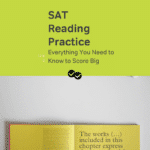Each section of the SAT asks its own types of questions, so each section requires a slightly different strategic approach. Today, we’ll be discussing some tricks for tackling the Reading section of the newly redesigned SAT.
Tip #1: Annotate!
If you do nothing else from this list, do this. Chances are good you’ve had to annotate something for English class sometime in the last couple of years. Time to bust out those skills! All the reading passages on the test will be over 600 words, which means you’ll be trying to absorb a lot of information at once and then trying to apply it to ten or so questions. As you go through the passage, pause after every one or two paragraphs to ask yourself: What did I just read? Next to each section, jot one or two words to remind yourself what it was about. Keep an eye out for main ideas and topic sentences, since there will always be at least one question on those. If the author has a clear agenda or bias, make note of that, too. This sounds like a lot of work, but the few seconds you spend doing this will pay off when you read a question and know exactly where to find the answer because of your notes.
Trick #2: Refer to the SAT graphs first.
Some of the reading passages will be paired with graphs and/or charts. Questions that reference them will almost always ask you to use information from both the graph and the passage to answer them. Check the graph first. Visual information is often easier for us to absorb than written information, and you can often eliminate at least one or two answers based solely on the graph. Then return to your (annotated) passage and compare its claims with the graphed data to make your final choice.
Tip #3: Build your comfort with older language.
This trick works best if you have plenty of time before your test. Every Reading section will include a “Founding Documents” passage, from the 18th-19th centuries, and a “Global Conversation” passage, from any era. The language you will encounter in these passages is often difficult for modern students to decipher. If you’re lucky, the “Founding Document” will be something you’ve seen before, such as part of the Declaration of Independence, but there is no guarantee that it will be. The best way of making sure you are prepared for these passages is to expose yourself to that type of writing before taking the test. Revisit documents you might have studied in English or History to refresh your memory. You can also take a look at Project Gutenberg, which has free, digital copies of works from every era and on tons of subjects. Even a little familiarity with older language can remove some of the anxiety of dealing with it on a timed test.
Trick #4: Find your groove.
Remember that you can tackle the test however you feel you work best. Don’t feel like you have to follow the test linearly from start to finish or that you have to completely read each passage before starting to answer the questions. Some students might find it easier to tackle SAT comparison passages right at the beginning of the test, then move on to the single passages. Some like to leave them for last because they can suck up the most time. Some like reading the whole passage, then addressing the questions, while others like to read half, answer some of the questions, then read and answer the rest. Try taking some timed practice tests and try out different approaches to find one that works for you. Once you’ve found your groove, stick to it!
Tip #5: Don’t panic!
Occasionally, you’ll encounter a passage that just doesn’t make sense to you. You’ll read it, annotate it, and still not be sure what it’s telling you. Don’t panic. Answer the questions that require less analysis, such as the Words in Context questions. Then tackle the questions that ask for something clearly stated (Hint: these will say something like “According to the passage…”). Only then tackle the harder ones. If you’re super stuck, make a best guess and move on. If you have extra time, you can always come back to the tough questions, and there is no penalty for wrong answers, so you might as well take a guess.
These five tricks will help you navigate the daunting new Reading section with more confidence. Remember to keep practicing!

In case you need a refresher, here is an overview of what the New SAT Reading is going to entail.






Leave a Reply